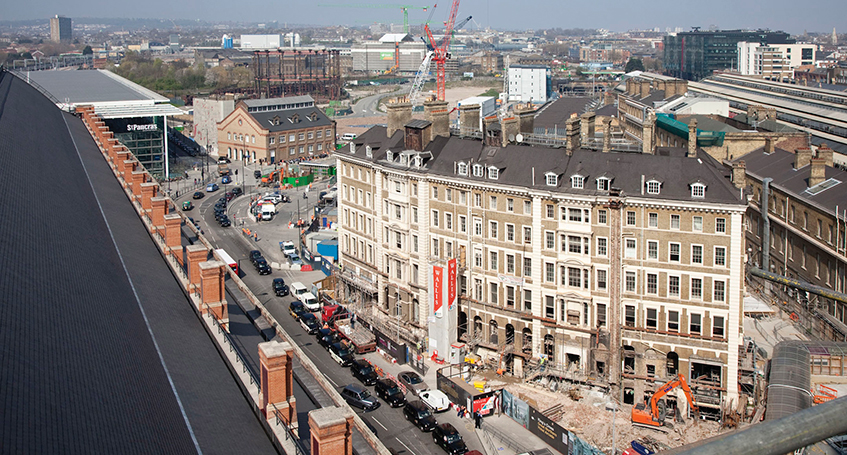COMMENT: What is the best measure for success in real estate? Is it just about rising values? Clearly that alone cannot be enough, particularly when it comes to long-term development and regeneration, which carries with it enormous social responsibility, writes Regeneris director Chris Paddock.
At Regeneris, we have been considering this question of measuring value in a broad-ranging and holistic way for some time, taking in not only commercial value, but the wider economic and social impacts of development.
And we are seeing increasing demand for this approach from developers and investors.
Most recently, Argent asked us to provide an analysis of the impact of the King’s Cross Central development since construction began back in 2008.
The report, called The Economic and Social Story of King’s Cross, published last week, gives us a good sense of what has been achieved, but also gives Argent some guidance on what it can do better and where it can go next.
Presenting this as a “story” became fundamental to our approach and helped us capture the broad evolution of impacts on site, avoiding temptation to generate one big number to show success.
From the outset, Argent had a clear vision for what it wanted to achieve on the 67-acre site and what success would look like.
As early as 2001, Argent, with its partners, published its Ten Principles for the Human City. This set broad objectives towards the creation of a new London neighbourhood; a “place”, in the fullest sense of the word, that is integrated with its surroundings, providing great architecture, well-designed public realm and is home to a vibrant mix of uses.
Early on in the process, Argent realised that success at King’s Cross needed to be considered not only from the point of view of investors or the occupiers, but also by residents, visitors, and neighbouring communities.
At the heart of this approach was a firm belief that creating a commercially successful development –a great “place” and a strong community – were not in tension with each other, rather they were intertwined and inseparable.

So to what extent has this approach been a success? Certainly the development has been widely lauded as an exemplar of urban regeneration and placemaking, both in the UK and internationally.
What our study set out to do was to objectively measure what has been achieved over the course of the development – not just in terms of the commercial property, but the wider economic and social impact of King’s Cross.
The headline figures are impressive. Since 2008, £3bn has been invested in construction on the site, supporting 1,300 jobs.
The Construction Skills Centre has supported 1,200 people into construction-related employment and strengthened local labour market by providing 600 apprenticeships and 450 NVQ L2 starts.
Some 1,500 suppliers have been used, including 300 local businesses, supporting 500 local jobs and generating gross value added of £33m per year in the local area.
More than 600 local people have been placed into work on site, including 330 previously unemployed local people – generating a public value of £4.6m per year.
The development has so far delivered 19 new and refurbished office buildings, providing 3m sq ft of commercial office space, with a 97% occupancy rate.
Some 8,500 employees now work in offices, shops and restaurants and cafés across the site, generating a total economic value of £480m per year (GVA).
Overall, the site attracted footfall of 7.5m during 2016, with visitor spend generating £480m GVA pa.
The scheme has also delivered 900 new homes, of which 325 (36%) can be classified as “affordable”, supporting £77m of additional local spend per year from new residents, which is estimated to have supported 200 jobs in the local area, and generated £1.4m in additional council tax per year.
The report also shows that over the past decade, King’s Cross has outperformed other inner London “Opportunity Areas”, as outlined in the London Plan, in terms of employment growth and increases in commercial and residential values.
Alongside those numbers there are the much harder to value social benefits – 600 young people and 420 businesses volunteers were involved in volunteering at Global Generation’s Skip Garden in 2015-16, while 50 schools and 3,800 pupils have been engaged in other on-site activities.
Of course, the report does not give a complete picture – and we quite deliberately focused on impacts that can be legitimately attributed to the development, rather than those that may be considered more tangential.
Nor does it mark the end of this story – it’s important to note that the full benefits of the development will not accrue until many years after it is completed (and it is currently only just over half complete).
Importantly, the report also gives Argent – and the industry as a whole – guidance as to processes they need to put in place to ensure more data is captured so that they can better understand the social impact of the development. These include:
- The economic and social impact and footprint of occupiers and tenants located within the King’s Cross estate.
- The value of previously unemployed people entering employment across King’s Cross (including within commercial tenants)
- The social impacts of providing access to affordable / intermediate housing
- The value of participation in the arts and leisure
- Social values associated with enhanced environment, crime and community belonging
Overall, we have concluded it is too early to provide a thorough assessment of the extent to which King’s Cross has “integrated” successfully and inclusively with existing communities locally.
There are good signs and some evidence of impact, but we believe that Argent and its partners need to put in place a longer-term approach to tracking social outcomes within neighbouring communities.
Building methodologies to track and demonstrate the social impact in the round of the development – particularly among existing local communities – is important, given Argent’s focus from the outset on social value.
But this applies equally to any developer undertaking regeneration, given the increased focus on social impact within the public sector since the 2012 Social Value Act.
Ultimately, putting in place a robust and consistent approach to tracking the impact of development is not so much a nice to have but increasingly a need to have, at a time when development and regeneration is facing ever greater levels of scrutiny.
This needn’t be a costly or resource intensive exercise, but clearly works better when it is embedded at an early stage alongside strong commitments and principles.
If the property industry can start measuring more effectively the wider impact of regeneration, then it can better demonstrate the value of what it delivers and make a stronger case for development when working with the public sector.
And that should lead to greater empathy between stakeholder groups and ultimately, to the creation of better places that are of value to all.
Chris Paddock is director at Regeneris.











